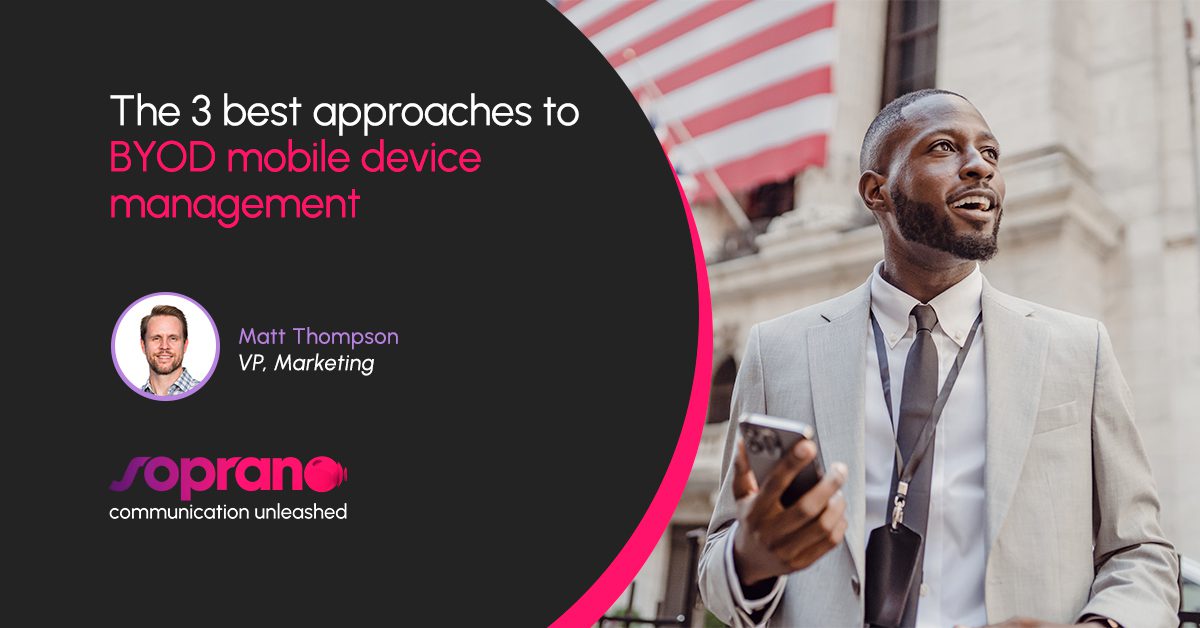
*Content updated in October 2022.
According to research, almost 70% of IT decision-makers in US companies approve of BYOD. Most of employees implement Bring-Your-Own-Device for contact management, calendar. But with the rise of mobile messaging apps, how do you protect your data and information from popular consumer apps like WhatsApp, Kik, and Facebook Messenger? Keep reading.
As these mobile messaging apps become increasingly used for work purposes, even the last holdouts in corporate IT departments are facing the fact that their employees are likely communicating sensitive information via insecure mobile apps, at least to some extent.
Additionally, an IT manager at pretty much any mid- to large-sized business can think of dozens, if not hundreds, of mobile applications that could help improve workflow productivity and reduce frustration for everyday tasks. Many businesses hope to deliver these apps to their workers through a mobile device management (MDM) system such as Mobile Iron or AirWatch, many of which have launched their own app store ecosystems designed to securely deliver useful apps to workers in this challenging bring-your-own-device (BYOD) environment.
Productivity increases by 34% when employees use smartphones - Moneyzine
Yet, these MDM app stores don’t provide even a fraction of all of the apps that workers would require, and these MDM app ecosystems are costly and demand an increasing level of oversight and training and rarely result in broad employee mobile use.
The challenge for the modern IT department is to balance the need for security with keeping costs low in a way that still allows employees to take advantage of the productivity gains that can be achieved through innovative mobile applications and solutions.
In this article, we’ll take a look at the three modern alternatives to managing a BYOD environment, including the aforementioned expensive MDM option, each of which can be evaluated as a solution for app management and custom app deployment for enterprises.
Let’s compare the good, bad, and ugly of each method.

1. BYOD – Develop and manage internal custom applications
Internal applications are developed in-house from scratch, primarily in large enterprises with the resources to devote to app development. They tend to be:
– Designed for specific use cases and often only adopted by power users.
– Narrowly focused on individual units.
– Created for a specific device or operating system.
- The good. Internal apps are by their nature extremely customisable, having been built from the ground up. You’re also in control of the features, roadmap, and bug fixes.
- The bad. Designing, building, and maintaining these apps take up a lot of internal resources, particularly for enterprises, where many different teams need specialized apps. These apps can also fall victim to competing internal priorities.
- The ugly. Unless you can put the time and resources into an extraordinary app that’s even better than consumer options, employees simply won’t use it. For example, we’ve seen a suspended access company that erects working platforms develop a custom mobile app for its field workers to send in photos of the breaking components on equipment at job sites , only to have those workers ignore the clunky app and use text messaging instead.
2. BYOD – Invest in mobile device management (MDM) solutions
For businesses that aren’t developing apps internally, commercially-available applications are appealing. However, securing these apps is expensive.
Many mid- to large-size companies are turning to mobile device management, or MDM, platforms for BYOD. These MDM solutions often include ‘walled gardens’ of mobile applications that allow employees to use pre-approved apps.
- The good. Apps within MDMs are available to any employee provisioned with the MDM software. Employees can usually access these apps with permission or restriction.
- The bad. If any company or company’s workers require any application that hasn’t already been added to the MDM’s ‘walled garden’ app store, then employees can’t use it unless they use it outside of the MDM environment, which negates the security and benefits of the MDM solution. If there is a policy prohibiting the use of non-MDM applications, then these workers are simply deprived of using the tools they genuinely need.Not to mention that MDM platforms are a very expensive way of deploying mobile applications to employees since they require companies to pay for both the MDM itself and the apps within it.The consumer apps within MDMs can also encounter issues or go down entirely. (Think 2015’s massive global Skype outage or BlackBerry’s plan to cease service in Pakistan.)In either case, employees will seek workarounds that aren’t necessarily stable or secure.
- The ugly. Paying for an MDM solution may simply be overkill for many companies. If you’re paying $30 per month per user so that you can have secure access and control you’re your niche internal mobile applications for workers then you’re essentially paying the entire MDM fee to deliver an app.

3. BYOD – Deliver apps to your workers within a mobile messaging app
Nearly everyone uses mobile messaging, for both work and personal purposes.
The emerging method of managing utility or niche apps in a BYOD environment is to deploy these apps straight into a business-grade mobile messaging application, such as our IP Messaging Solution.
These modern mobile messaging apps can enable mobile forms and custom-designed application for just about any use case imaginable, and delivered into a secure mobile messaging apps that is purpose-built for enterprise. Not only can the custom apps be created quickly and cheaply, but they can be integrated with IT systems and software to consolidating most employees’ mobile needs into one location on the device, effectively replicating the benefits of the costlier MDM software solutions on the market.
For example, you might roll out a business-grade mobile messaging app to your team, and then deliver a custom-fit timekeeping workflow mobile form into the same app to enable button-based messages that allow employees to submit a timesheet from within the messaging app with the press of a button, and have that time sheet sent along to your payroll system. The employee could accomplish this workflow in seconds, and remain in the app for secure mobile chat with team members.
- The good. Secure enterprise messaging apps can combine a secure environment for workflow applications, with integration points and APIs to provide a way to deliver custom worker applications into a secure environment. There’s no need to develop expensive mobile apps internally from scratch, or to maintain a ‘walled garden’ MDM app ecosystem or overpay for security. And the app will be useful to the workers since mobile messaging is ubiquitous and a user-friendly secure messaging app is an ideal way to ensure employees aren’t introducing more consumer-level workarounds into your IT environment.
- The bad. The approach also requires an enterprise BYOD policy that specifies that employees don’t bring apps from the outside, but the utility of apps such as Soprano IP Messaging solution could alleviate this concern over time, as employees become familiar with the option of deploying their ideas into custom workflow experiences within the messaging app.
The next step for secure mobile apps
Soprano offers enterprise-grade mobile enterprise messaging solutions for businesses to address these BYOD security and productivity concerns.
Soprano IP Messaging solution is a breakthrough mobile messaging technology for enterprise and business, designed to have a simple “SMS-like” feel to preserve the productivity and immediacy of SMS, while delivering a sophisticated and secure business messaging experience for mission-critical IT environments and worker experiences.
In addition, Soprano’s custom mobile app builder tools can provide a unique productivity experience for workers delivered within a secure and compliant environment.
Unlike consumer mobile messaging apps, we offer three layers of security, a unique workflow messages capability that introduces mobile forms into a mobile chat environment, and sophisticated acknowledgement and auditing capabilities. Our IP solution also distinguishes itself by enabling custom integration and automation for feature-rich multimedia IP messaging.
